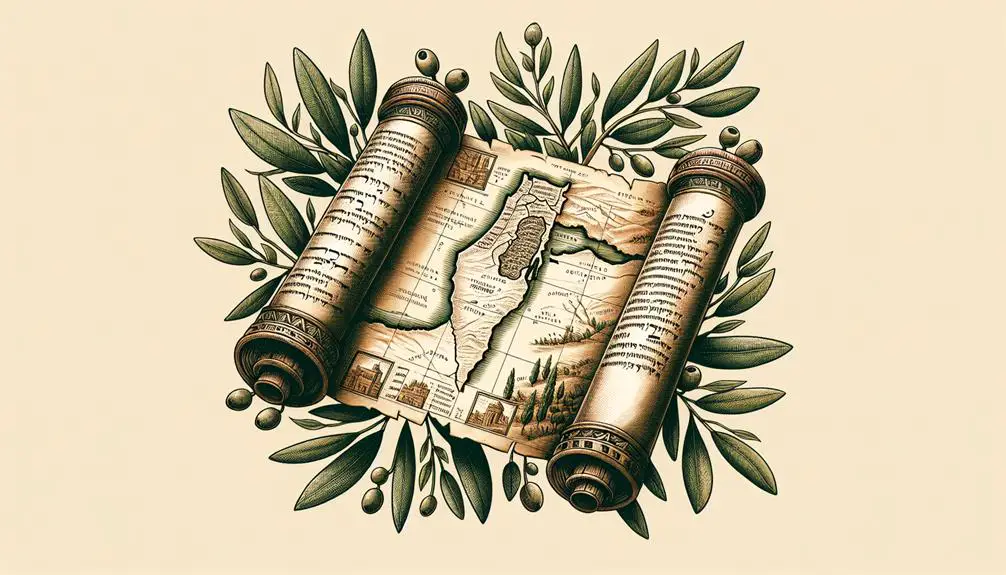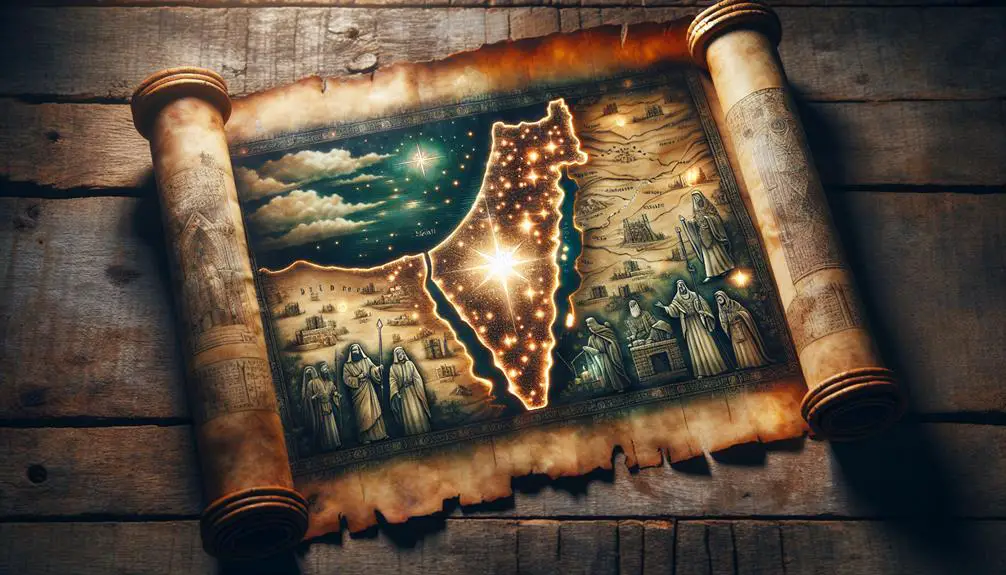Find out when Palestine was first mentioned in the Bible, unlocking ancient secrets and stirring curiosity for deeper exploration.

When Was Palestine First Mentioned in the Bible
Since the dawn of time, or so it seems, scholars and historians have hotly debated the first mention of Palestine in the Bible.
You're about to embark on a journey through ancient texts, where names and places intertwine with the spiritual and historical fabric of humanity.
The earliest biblical mention of Palestine is not just a passing reference; it's a gateway into understanding the profound significance of this land.
As you explore the historical background, biblical geography, and archaeological insights, you'll uncover layers of meaning that have captivated generations.
Just when you think you've grasped the essence, you'll find there's always more to uncover, leaving you poised on the brink of further discovery.
Key Takeaways
- The term 'Palestine' evolves and is not originally used in the Hebrew Bible, which mentions Canaan, Philistia, or Land of Israel instead.
- Biblical mentions and their varied names reflect the complex history and socio-political dynamics of the region.
- Etymological origins of 'Palestine' trace back to ancient civilizations, indicating a later introduction into historical narratives.
- Understanding the term 'Palestine' in biblical context requires analyzing scriptural variations and cultural implications from different traditions.
Historical Background of Palestine

Delving into the historical background of Palestine, it's essential to recognize that this region, nestled at the crossroads of continents and civilizations, has been a melting pot of cultures, peoples, and religions since ancient times. The evolution of this area under various dominions, notably Roman rule and the Ottoman Empire, has profoundly shaped its identity and heritage.
Under Roman rule, which began in the 1st century BC, Palestine underwent significant transformations. The Romans introduced new administrative systems, infrastructure, and urbanization, reshaping the landscape and societal structures. Yet, this era was also marked by tumult and rebellion, as the indigenous populations resisted Roman imposition, leading to notable revolts. The Roman response was often severe, culminating in the destruction of the Second Temple in Jerusalem, a pivotal event that reshaped Jewish history and identity.
Transitioning to the Ottoman Empire's stewardship starting in the early 16th century, Palestine entered a new phase. The Ottomans, ruling until the early 20th century, implemented their own administrative practices, including the millet system, which allowed a degree of religious autonomy within a structured imperial framework. This period saw relative stability, but also challenges, as the empire's declining power in its later years led to increased foreign intervention and internal strife.
Analyzing these eras, you'll find that both Roman and Ottoman rules left indelible marks on Palestine's social, cultural, and physical landscape. Their legacies, layered amidst the region's rich tapestry, contribute to the complex historical narrative that defines Palestine today.
Understanding Biblical Geography

To fully grasp the historical and cultural context of biblical narratives, it's crucial to understand the geography of Palestine during biblical times. The landscape where these stories unfolded is significantly different from what you'd recognize today. Geographic evolution and shifting modern boundaries have transformed the region, altering its relevance and significance over centuries.
Here are key aspects to consider:
- Varied Landscapes: Palestine's biblical geography spans from lush valleys and fertile plains to harsh deserts and rugged mountains. This diversity influenced the lifestyles, economies, and warfare tactics of ancient peoples.
- Strategic Location: Situated at the crossroads of Africa, Asia, and Europe, its position on ancient trade routes bestowed strategic and economic advantages, making it a coveted land among empires.
- Water Sources: Access to water sources, like the Jordan River and the Sea of Galilee, was vital for survival and development, shaping settlement patterns and stories of biblical significance.
- Modern Boundaries vs. Biblical Lands: Today's political borders don't align with the ancient divisions of lands and territories mentioned in the Bible. Understanding this discrepancy is essential for accurately contextualizing biblical events and narratives.
Analyzing the geography of biblical times illuminates the backdrop against which the tapestry of biblical history was woven. It's not just about recognizing names on a map; it's about understanding how the physical landscape shaped the spiritual, social, and political fabric of the time. As you delve deeper into biblical stories, keep in mind the dynamic interplay between people and their environment, influenced by geographic evolution and the changing contours of modern boundaries.
The Earliest Biblical Mention

The earliest biblical mention of Palestine sets the stage for understanding its pivotal role in the historical and spiritual narratives of the Bible. You're venturing into a complex terrain where translation challenges and scriptural variations offer a rich but intricate landscape to navigate.
As you delve deeper, it's crucial to grasp that the term 'Palestine' itself undergoes a transformation through the ages, influenced heavily by linguistic shifts and the evolving context of the texts. The Hebrew Bible, or Tanakh, doesn't directly use the modern term 'Palestine'; instead, it refers to regions such as Canaan, Philistia, or the Land of Israel, each carrying distinct connotations and historical contexts. The challenge in pinpointing the earliest mention lies in the fluidity with which these terms are treated across different scriptural translations.
Moreover, scriptural variations add another layer of complexity. Different manuscripts and traditions—be it Jewish, Christian, or others—may present divergent names and descriptions for the same geographical entities. This inconsistency isn't merely academic but feeds into broader interpretations of biblical history and its geographical assertions.
Understanding these nuances is paramount. The task at hand isn't just about tracing a name back through time but about appreciating the multifaceted relationship between a land, its people, and their collective memory as encapsulated in their sacred texts. As you navigate these ancient narratives, remember that you're not just tracing a term but uncovering the layers of historical, cultural, and spiritual significance that have shaped the identity of a region through millennia.
The Significance of the Name

Understanding the significance of the name 'Palestine' requires an exploration of its etymological roots and the historical narratives that have shaped its meaning over centuries. The name itself is layered with cultural implications and reflects a complex history that's intertwined with various naming conventions. These conventions aren't merely labels but serve as a testament to the socio-political and cultural dynamics of the region throughout history.
- Etymological Origins: The name 'Palestine' has roots that trace back to ancient civilizations, reflecting shifts in power and cultural dominance.
- Cultural Implications: The naming of a region often carries deep cultural significance, embodying the identity and historical narratives of its people.
- Naming Conventions: These conventions reveal the historical context in which they were adopted, showcasing the influence of various rulers and empires over the region.
- Historical Narratives: The name 'Palestine' encapsulates a multitude of stories, conflicts, and periods of peace, mirroring the complex history of the region.
Archaeological Insights

Archaeological excavations in the region have unveiled artifacts and structures that shed light on the daily lives, religious practices, and political dynamics of ancient Palestine. With the use of modern excavation techniques, archaeologists are uncovering evidence that helps us understand the complex tapestry of history that constitutes this area. You'll find that the focus on artifact preservation has become crucial, ensuring that these valuable insights do not decay with time.
Here's a glimpse into some key findings:
Artifact/Structure |
Description |
Significance |
|---|---|---|
Pottery Shards |
Various forms and decorations |
Indicate trade routes and cultural influences |
Ancient Coins |
Inscribed with faces and names of rulers |
Reflect political changes and economic practices |
Temples and Altars |
Structures dedicated to worship |
Provide insight into religious practices and deities |
Inscriptions |
Carved or written on stone and walls |
Offer firsthand accounts of historical events |
Tools and Weapons |
Made from bone, stone, and metal |
Show technological advancements and daily activities |
These discoveries, each with its own story, paint a vivid picture of what life might have been like in ancient Palestine. The careful excavation and meticulous preservation of these artifacts allow you to step back in time, offering a tangible connection to the past. As you delve deeper into the archaeological insights, you're not just uncovering the physical remnants of history but also piecing together the social fabric that defined an era. Through these findings, the ancient world of Palestine comes to life, bridging the gap between past and present.
Palestine in Biblical Prophecy

Exploring ancient Palestine through its artifacts and structures reveals much about its historical context, yet examining its place in biblical prophecy offers a further dimension to our understanding of this ancient land. The prophetic texts of the Bible mention Palestine in various contexts, each carrying its own set of interpretations and implications for the past, present, and future.
- Historical Context: Prophetic references to Palestine often reflect the historical and political realities of the time, serving as a lens through which to view the struggles and aspirations of its people.
- Symbolic Significance: In prophecy, Palestine frequently symbolizes a land of spiritual significance, embodying themes of promise, judgment, and restoration that resonate beyond its geographical boundaries.
- Prophetic Interpretations: Understanding these prophecies involves deciphering ancient metaphors and symbols, a task that has led to diverse interpretations among scholars and theologians.
- Modern Implications: The prophetic mentions of Palestine continue to influence contemporary political and religious discourse, highlighting the deeply intertwined nature of faith, history, and modern geopolitics.
The role of Palestine in biblical prophecy is multifaceted, reflecting a complex interplay between divine messages and human history. Prophetic interpretations offer insights into the spiritual significance attributed to this land, while the modern implications of these prophecies underscore the enduring influence of these ancient texts on today's world. As you delve into the prophetic references to Palestine, you're invited to consider not only their historical context but also their relevance to contemporary issues and debates.
Interpreting Ancient Texts

You must consider the historical contexts to fully grasp the complexities of ancient Palestine narratives.
Analyzing linguistic nuances reveals how meanings shift over time and context.
Deciphering symbolic meanings, finally, uncovers layers of interpretation that are crucial for an accurate understanding of these texts.
Understanding Historical Contexts
To fully grasp the narratives of ancient texts, it's essential to delve into the historical contexts surrounding Palestine during biblical times. Understanding these contexts is crucial for accurate cultural interpretations and assessing their modern implications.
- Geographical Importance: Palestine's location as a crossroads of civilizations influenced its diverse cultural and religious landscape.
- Political Dynamics: The area's changing control among empires affected its representation in biblical narratives.
- Societal Structures: Knowing the social hierarchy and family structures helps clarify biblical stories' societal roles.
- Economic Factors: The economic backdrop, including trade routes and agricultural practices, provides insights into the daily lives depicted.
Analyzing these aspects enriches your comprehension of ancient texts, offering a more nuanced understanding of their stories and teachings.
Analyzing Linguistic Nuances
Building on a foundational understanding of historical contexts, we'll now examine the linguistic nuances that shape interpretations of ancient texts.
You'll find that the semantic evolution of words plays a crucial role in understanding how locations, like Palestine, were referred to across different epochs. Ancient languages, including Hebrew, Aramaic, and Greek, exhibit significant shifts in meaning that challenge modern translators.
These translation challenges aren't merely technical; they require a deep understanding of the cultural and historical milieu from which these texts emerge. As words change in meaning over centuries, pinpointing the exact references in ancient manuscripts necessitates a meticulous analysis.
This task is compounded by the fact that translators must navigate the fine line between literal translations and capturing the essence of the original texts.
Deciphering Symbolic Meanings
Ancient texts' symbolic meanings often unlock deeper layers of understanding that go beyond their literal interpretation. When you dive into the symbolism within the Bible's references to Palestine, you're not just reading ancient history; you're uncovering a treasure trove of insights that resonate even in today's context of modern symbolism and cultural interpretations.
- Modern symbolism: How ancient symbols find relevance in today's world.
- Cultural interpretations: The diverse ways cultures interpret biblical symbols.
- Analyzing context: The importance of historical and cultural context in interpretation.
- Symbol versus literal: Learning to distinguish between symbolic and literal meanings.
Frequently Asked Questions
How Has the Modern Political Situation in the Middle East Influenced Interpretations of Biblical Mentions of Palestine?
The modern political situation in the Middle East has deeply influenced how you interpret biblical mentions of Palestine. Climate change and technological advancements have reshaped your understanding, making you reevaluate historical contexts with contemporary issues in mind.
This analysis isn't just academic; it's crucial for understanding ongoing conflicts and negotiations. You're seeing ancient texts through a lens shaped by current geopolitical climates, which significantly alters interpretations and relevance to today's world.
Are There Any Significant Differences in How Jewish, Christian, and Islamic Traditions Interpret the Mentions of Palestine in Their Religious Texts?
You'll find that Jewish, Christian, and Islamic traditions indeed interpret mentions of Palestine in their sacred texts differently. Through textual analysis, you can observe the nuanced variations in religious narratives surrounding this region.
Each tradition brings its own perspective, shaped by theological beliefs and historical contexts. These differences in interpretation highlight the complex relationship each faith has with the concept of Palestine, reflecting broader disputes and agreements within and between these communities.
How Do Contemporary Palestinian and Israeli Historians View the Biblical Mentions of Palestine in Relation to National Identity?
As they say, 'history is written by the victors,' but when it comes to how contemporary Palestinian and Israeli historians view biblical mentions of Palestine, it's more about uncovering truths.
They delve into ancient inscriptions and cultural festivals to understand their ancestors' lives and beliefs.
These scholars analyze these mentions not just as historical facts but as pieces of a puzzle that shape today's national identities, offering insights from both sides of the story.
What Role Does the Mention of Palestine in the Bible Play in Current Interfaith Dialogues and Peacebuilding Efforts in the Region?
The mention of Palestine in the Bible plays a significant role in current interfaith dialogues and peacebuilding efforts.
It's used as a common historical reference point in cultural festivals and educational programs, fostering understanding and cooperation among diverse religious communities.
This shared heritage helps bridge divides, encouraging dialogue over discord.
How Have Archaeological Discoveries Outside of the Traditional Biblical Lands Impacted Our Understanding of Ancient Palestine's Connections With Neighboring Civilizations?
Archaeological discoveries have opened a window to the past, revealing how ancient Palestine wasn't an island unto itself but a bustling hub in a vast network.
Ancient scripts and artifacts unearthed in regions far from traditional biblical lands showcase Palestine's integral role in maritime trade with neighboring civilizations.
This evidence paints a detailed, objective picture of a society deeply interconnected, challenging our understanding and highlighting its significance in the ancient world.
Conclusion
As you've journeyed through the historical and biblical landscapes of Palestine, it's clear that its mention weaves a complex tapestry of faith, culture, and geopolitics.
The earliest biblical mention, often linked to the Philistines in Genesis, showcases the deep roots of this land in human history.
Consider the tale of David and Goliath—a story not just of individual triumph but of the enduring spirit of a land embroiled in conflict and hope.
Analyzing these ancient texts offers a lens into how narratives shape our understanding of sacred and contested spaces.



Sign up